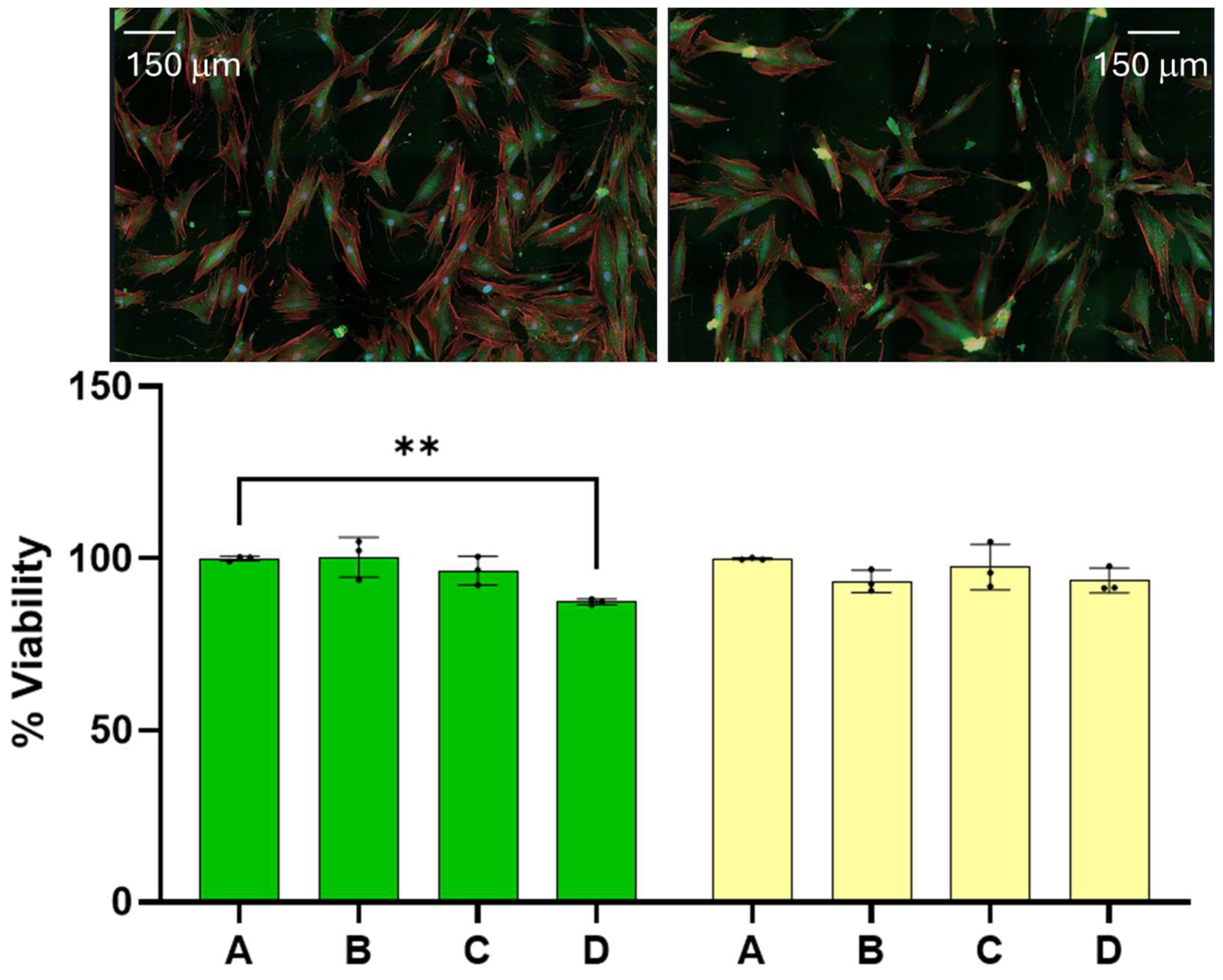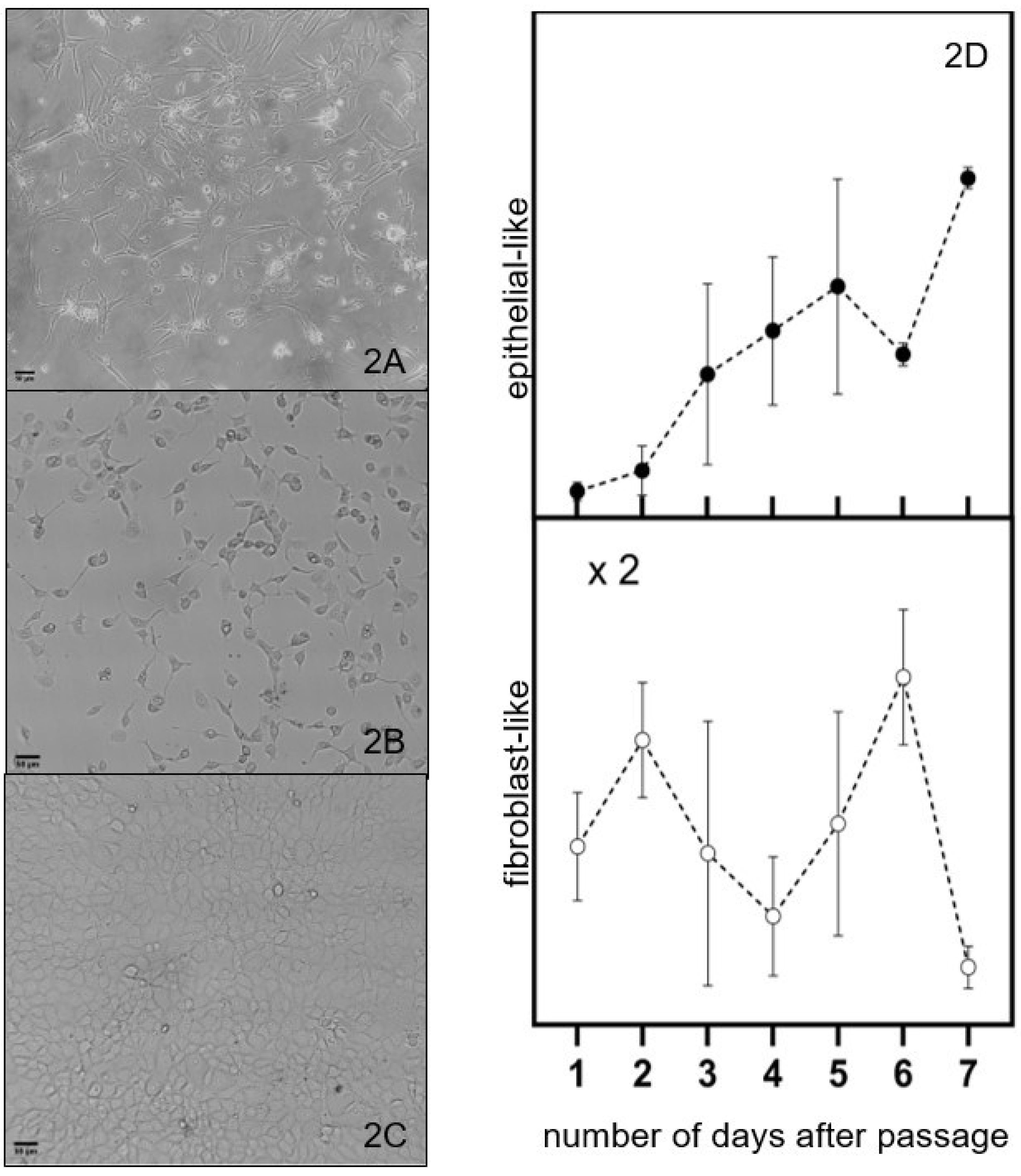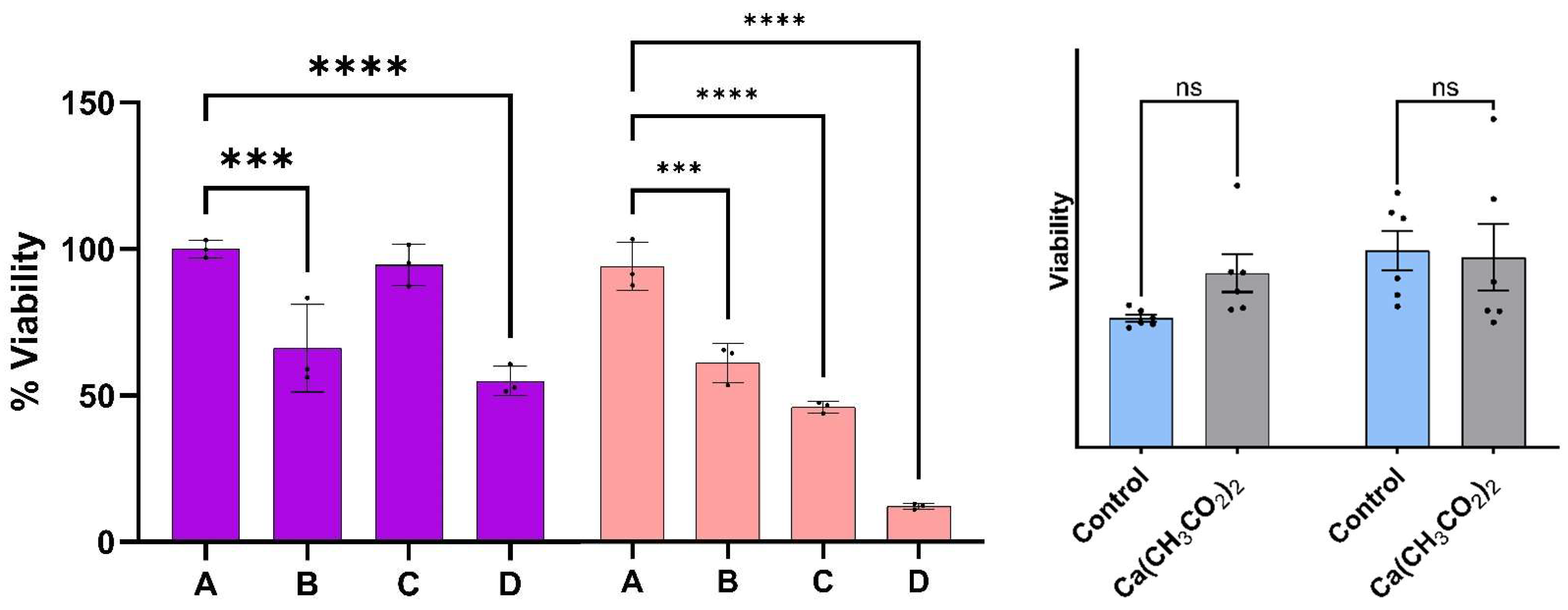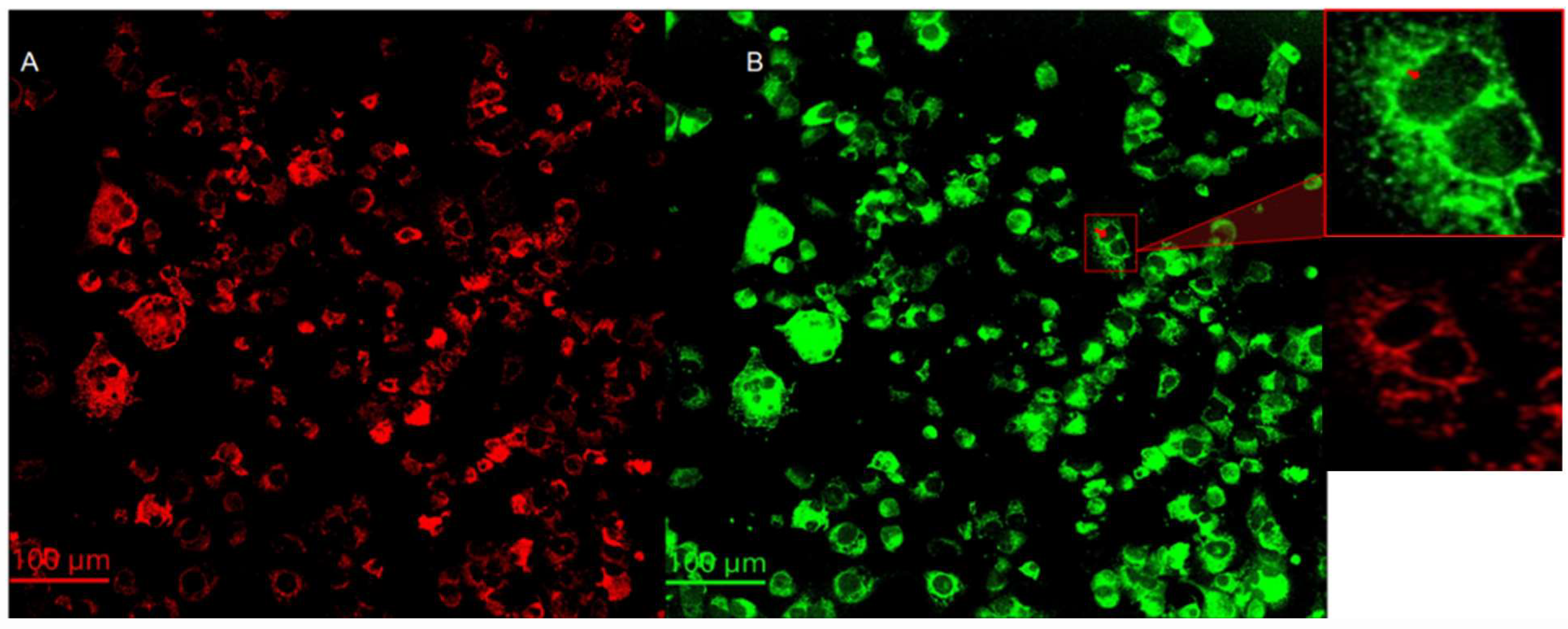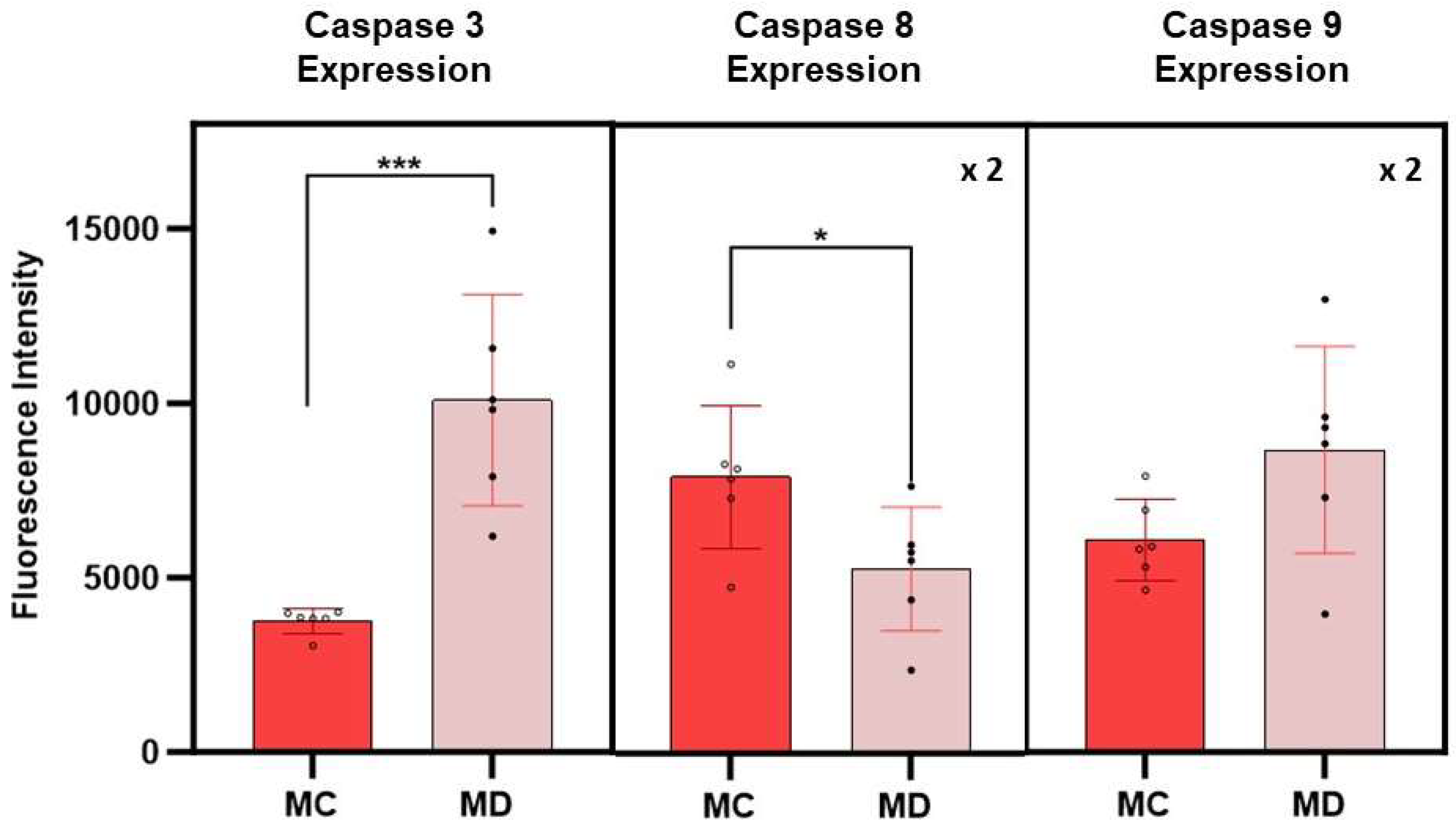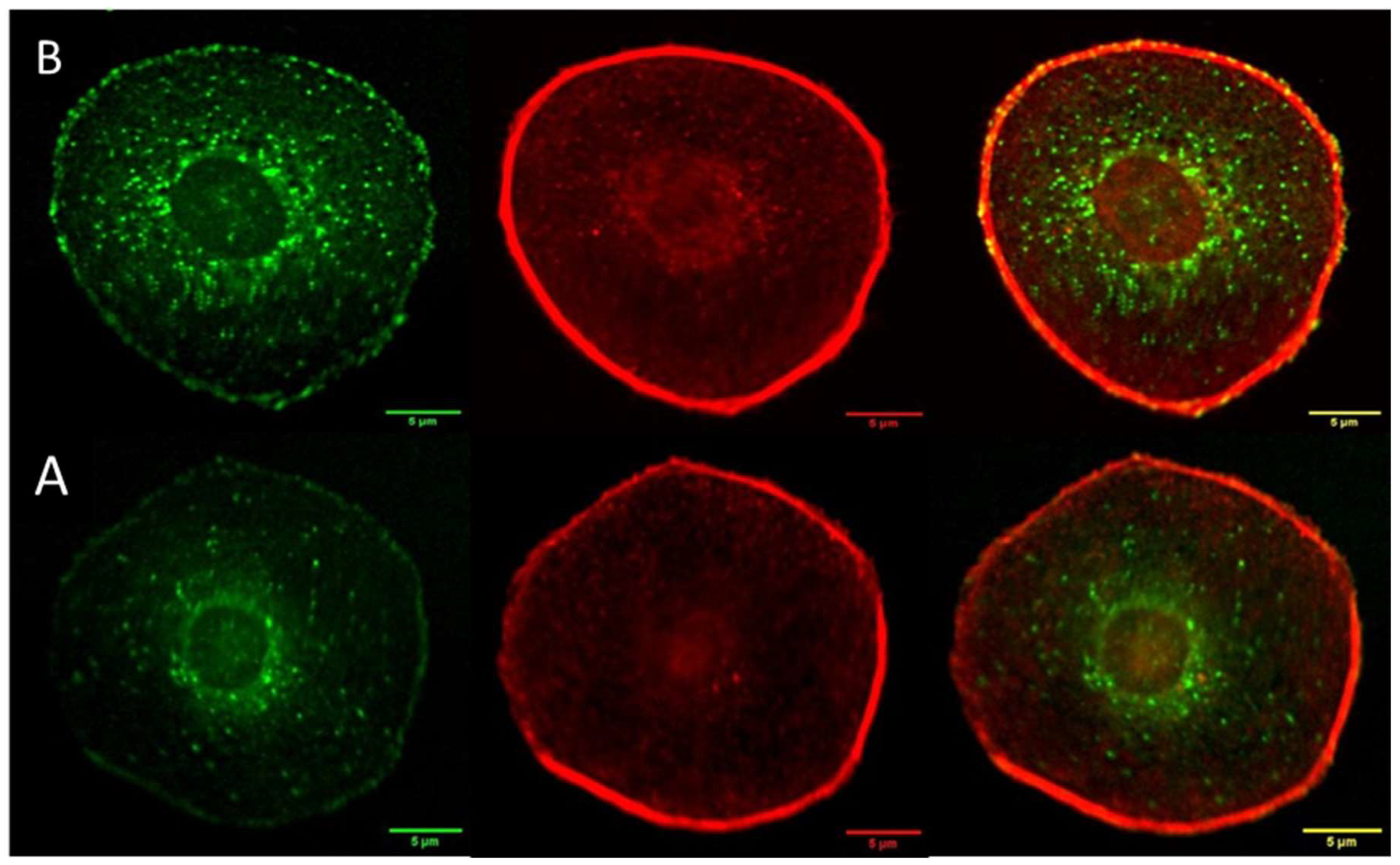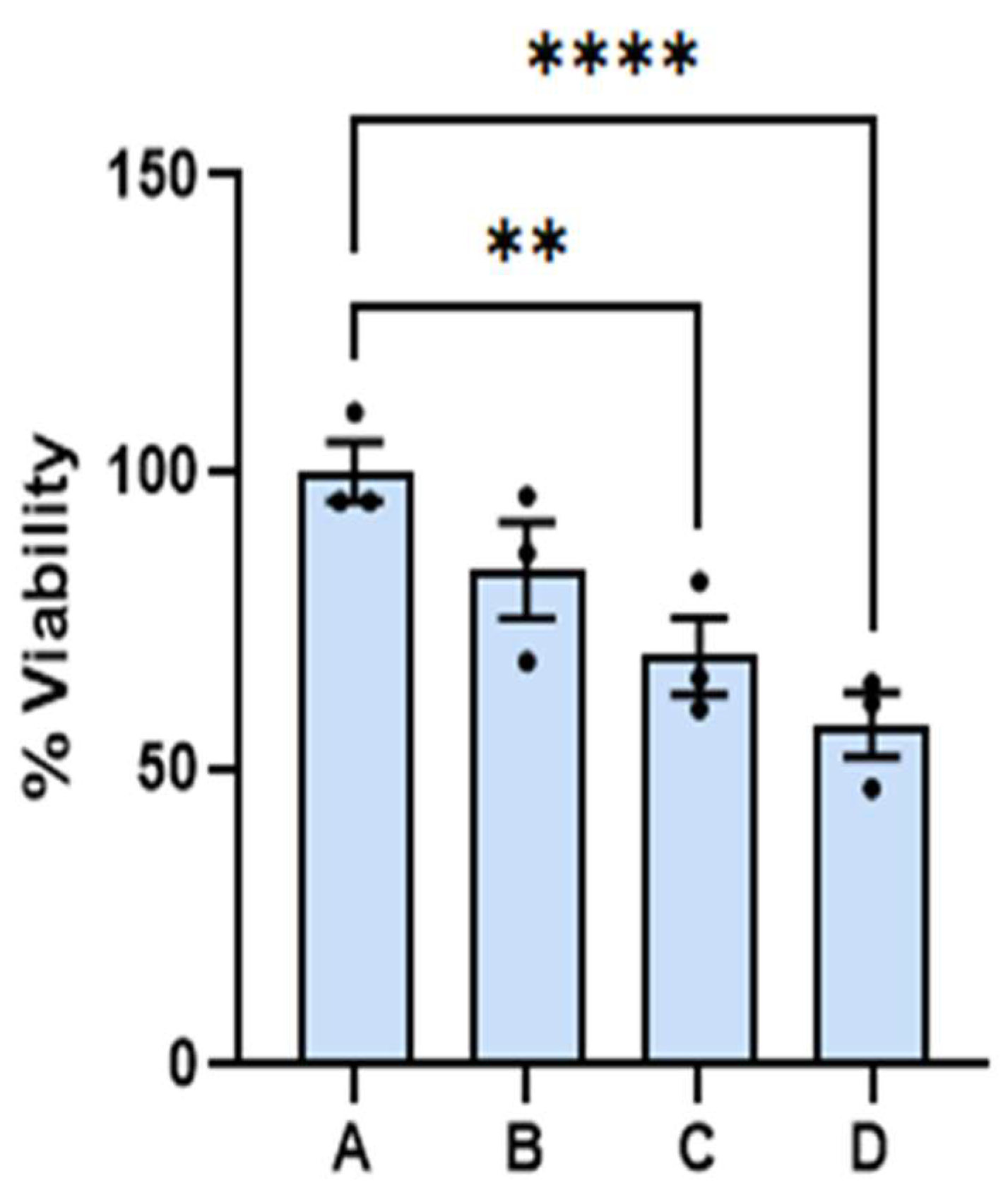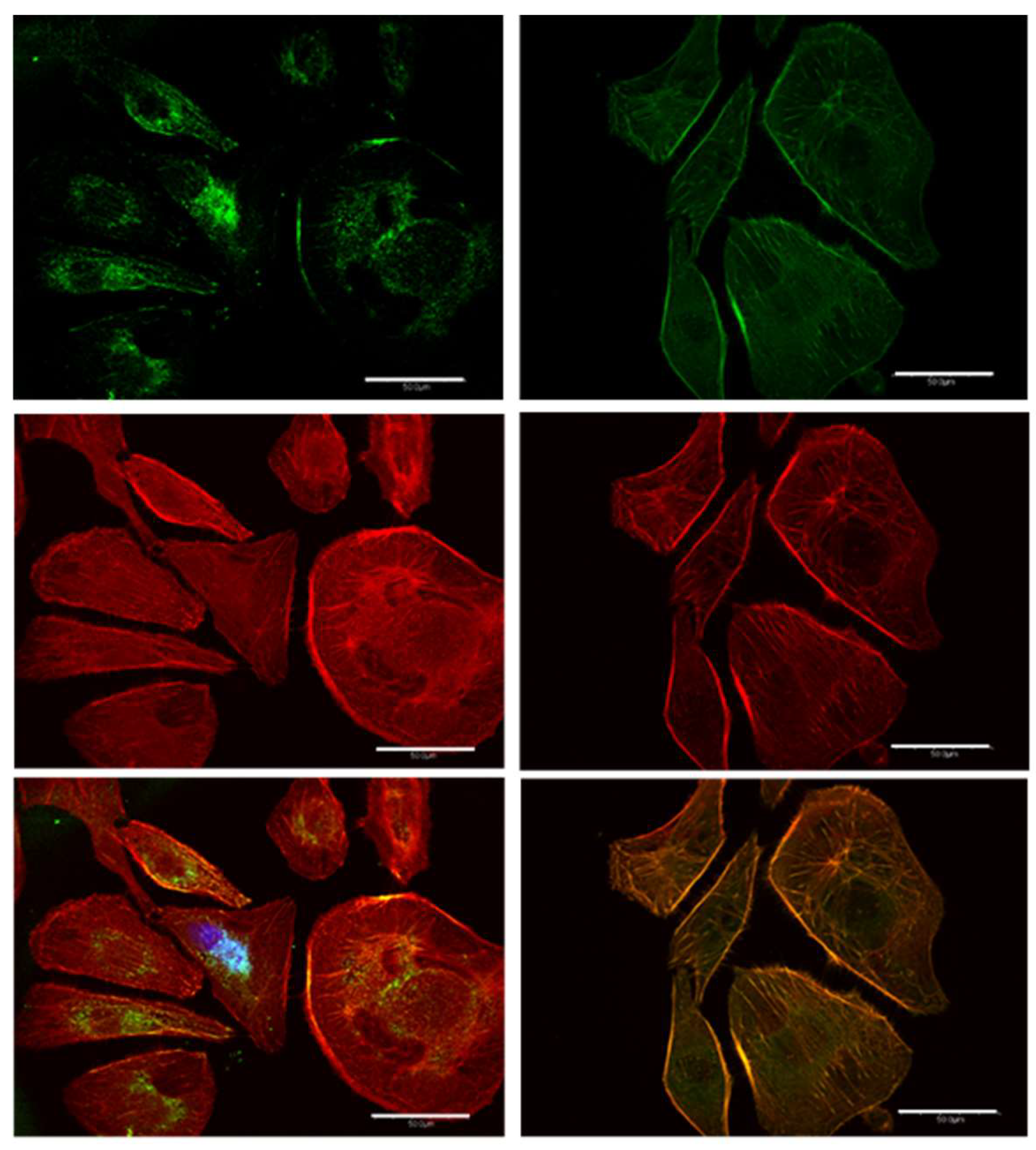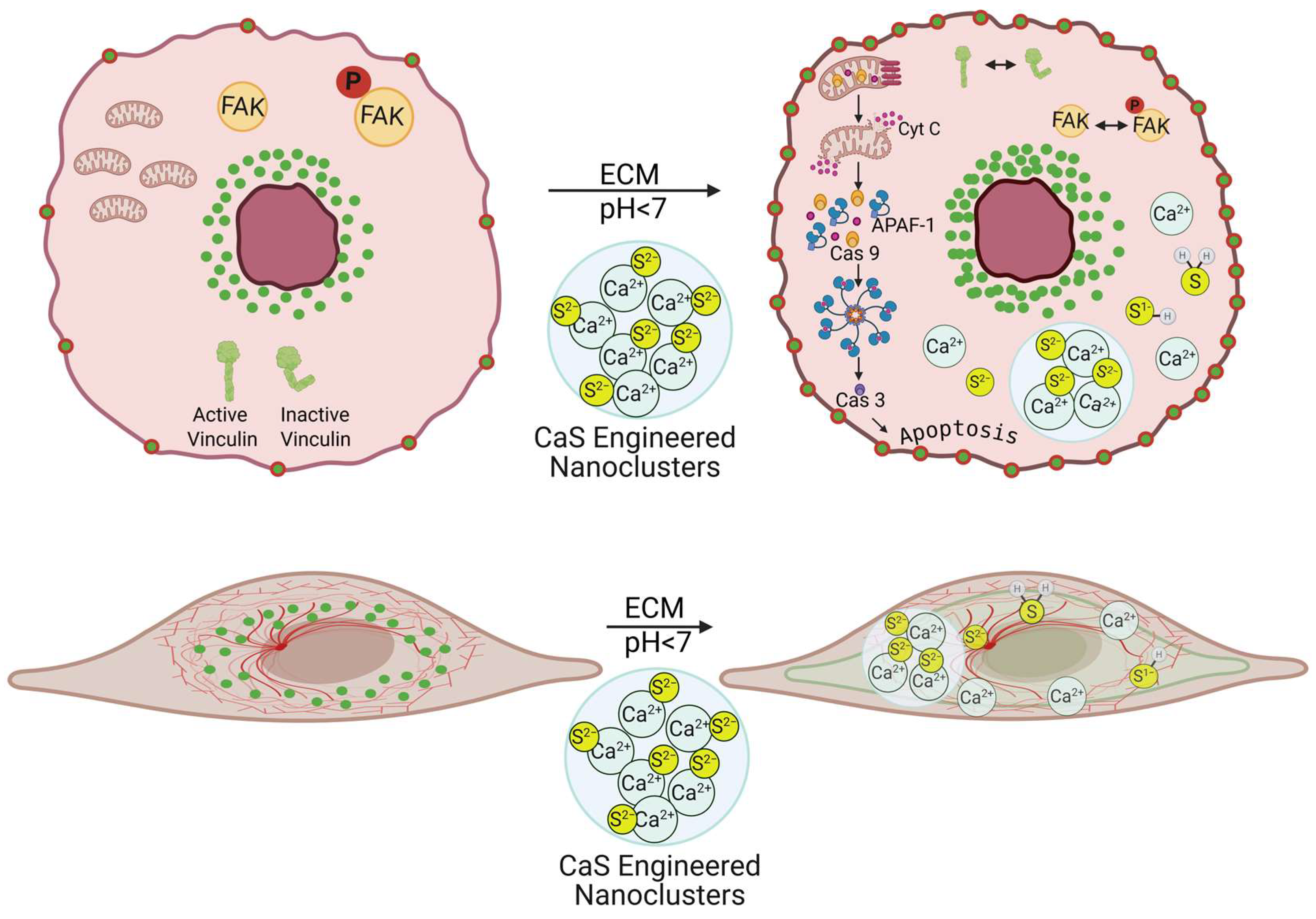1. Introduction
About 200,000 cases of melanoma have been diagnosed in the USA according to the American Cancer Society. The early state of melanoma is a localized cancer, with a 5-year survival rate of 94%. However, a late diagnosis or intervention may be fatal: melanoma is the most metastatic type of cancer. Indeed, only 32% of patients survive metastasis. Melanoma has the capacity to use the host microenvironment to promote cellular proliferation and tumor growth, switching between different phenotypes. In nature, melanoma is highly angiogenic and mesenchymal [
1]. The mesenchymal phenotype has well-defined actin fibers, including dynamic actin-rich protrusions such as filopodia and lamellipodia at their leading edges. These protrusions are involved in cell migration and are powered by the dynamic polymerization and depolymerization of actin filaments. Those in the epithelial state, on the other hand, are characterized by well-organized cortical actin network located just beneath the plasma membrane. This network supports the cell’s shape and maintains a tight, sheet-like structure.
Melanoma cells with epithelial phenotypes play central roles in the formation of localized tumors due to their proliferative characteristics [
2]. Melanoma cells with mesenchymal phenotypes are more difficult to treat with chemotherapeutic agents because of higher mobility and metastatic characteristics [
2]. The dynamic actin cytoskeleton facilitates this behavior, allowing cells to crawl along surfaces and navigate through tissues, forming focal adhesion points. This diversity may result in a complicated design of chemotherapeutic agents to reduce melanoma cell proliferation and/or metastasis. During melanoma progression, cells may undergo an epithelial-to-mesenchymal transition (EMT), where they lose epithelial characteristics and gain mesenchymal properties. This transition involves significant changes in actin organization, including loss of tight junctions and enhanced stress fiber formation. EMT is a complex process that involves transcription factors and genes [
3]. These transitions are bidirectional and play a central role in facilitating melanoma cell migration to nearby and distant tissues and organs [
4]. EMT is associated with melanoma metastasis [
5].
Cell adhesion and migration depend on intracellular processes and their interactions with the extracellular matrix through important groups of proteins that constitute the focal adhesion points (FAP) [
6]. These FAP are crucial for cell migration and are involved in signaling pathways that regulate cell movement and response to the extracellular environment. FAP complexes are formed from the interactions among various proteins and kinases, including vinculin, actin, talin, paxillin, integrin, focal adhesion kinase (FAK), proto-oncogene tyrosine-protein kinase (SRC), and PI3K, among others [
4]. In normal cells, regulation of the focal adhesion point formation is largely due to activation and de-activation of several of these proteins [
7]. This regulation mechanism plays a significant role in controlling cell death and proliferation [
8]. The regulation of proper FAK as well as other kinases requires adequate phosphorylation and de-phosphorylation of tyrosine residues by cysteine residues. Cysteine is usually present in the non-protonated state with a negatively charged sulfur end (C
3H
6NO
2S
−). Thus, it is plausible that chemical systems that can provide sulfides can enhance regulation of the dephosphorylation of kinases, similar to the sulfide end in cysteine residues that can trickle down, with a reduction in malignant cell viability [
9].
CaS (calcium–sulfur) is used as a remedy in alternative medicine to treat colds, coughs, sore throats, croup, abscesses, earaches, inflamed cuts and wounds, asthma, arthritis, emphysema, herpes, constipation, conjunctivitis,
Candida albicans infections, syphilis, sinusitis, and skin infections [
10]. Compared to many popular nanomaterials, including noble metals and magnetic nanoparticles, calcium- and sulfur-based nanostructures are promising biocompatible inorganic materials. Calcium is an abundant mineral in the human body. It plays major roles in both in macroscopic biological functions such as bones remodeling and biological functions at the molecular level such as intracellular and extracellular communication, protein structures, and mitochondrial metabolism. Sulfides, on the other hand, are present in the human body mostly in organic compounds like proteins and genetic material, and they are now postulated as a neuromodulators/transmitter with important physiological properties [
11].
The pH of normal and tumor cells depends on the tissue from which the sample is taken. The extracellular pH (pHe) of benign cells is slightly basic and ranges from 7.35 to about 7.8, while the pH
e values of cancer cells are more acidic, with values as low as 6.2 [
12]. This difference in pH offers a unique opportunity to design and develop technologies that can selectively act on malignant tumors with little effect on benign tissue. In this regard, CaS may represent a unique opportunity to engineer technologies to selectively limit cancer cell viability. In proton-deficient environments, like the extracellular matrix of benign cells, the dissociation of CaS into calcium and sulfide ions is a non-spontaneous process with a standard Gibbs free energy of reaction (ΔG°
rxn) of +9.2 kJ/mol. In the proton-rich extracellular environment of cancer cells, on the other hand, the reaction of CaS with protons to form calcium ions and protonated sulfides is highly exergonic, with ΔG°
rxn that ranges from −109.7 to −103.58, with the exact value depending on the protonated form of sulfide formed. Thus, the formation of Ca
2+ and H
2S is thermodynamically favored in the acidic pH found in the extracellular fluid of cancer cells but is limited in the basic extracellular environment of benign cells. Indeed, the experimental measurements reported earlier by our group are consistent with the pH-sensitive release of H
2S to the gas phase. In that work, the amount of H
2S detected from CaS was found to decrease with pH and was under detection limits at the more basic pH values [
13]. We hypothesized that the difference in pH results in the selectivity of the CaS nanostructures to limit the viability of breast [
14,
15,
16] and lung [
17,
18] cancer cells, with little effect on the corresponding benign cells. The quantitative results on the effect of CaS on breast and lung cancer cell viabilities are consistent with this hypothesis. We thus extended our earlier work on breast carcinoma and non-small-cell lung adenocarcinoma to skin melanoma with the hope of adding to the body evidence on the selective reduction in malignant cell viability by CaS.
2. Methodology and Approach
2.1. Cell Culture
Human Fibroblast cells CCD1090Sk (ATCC® CRL2106™; Manassas, VA, USA) and Melanoma cell line Hs 895.T (ATCC® CRL7637™) were passaged and maintained in complete cell media. The complete medium had a final composition of 89% Minimum Essential Medium (EMEM; ATCC) and Dulbecco’s Modification of Eagle’s Medium (DMEM; ATCC), respectively, with 10% Fetal Bovine Serum (FBS; ATCC) and 1% of Antibiotic Antimycotic Solution (Penicillin/Streptomycin/Amphotericin B solution), as supplied by ATCC; PCS-999-002. The experiments described below were performed with cells at 60–80% confluency.
2.2. CaS Dispersion Preparation
CaS dispersions were prepared as described in previous [
19,
20]. Briefly, a trace amount of laboratory grade calcium acetate (Ca (CH
3CO
2)
2), purchased from Fisher Scientific, was dissolved with 5 mL of dimethyl sulfoxide (DMSO), and the resulting dispersion was placed in a commercial microwave oven and warmed in intervals of 5 s until a total time of 30 s was accumulated. The resulting dispersion was found to be slightly yellow. The dispersions were characterized with scanning tunneling electron microscopy (STM), light scattering, and UV–visible absorption spectroscopy. STM measurements of dry deposits of the prepared material revealed structures with an average size of (3.3 ± 0.7) nm, while the light scattering measurements were consistent with particles smaller than (1.1 ± 0.2) nm: the larger particle size from the STM measurements likely results from coalescence of the dry deposits. Theoretical calculations focused on particle size volume were consistent with clusters containing a handful of CaS units were of the order of 1 nm [
18]. Features in the UV–visible absorptions spectra were also consistent with the optical absorption characteristics of clusters containing one and up to five CaS units.
2.3. Treatments
Cells were seeded in multiple well plates and incubated for about 24 h prior to the dispersion treatment. The culture medium was removed, and the desired treatment of dispersion mixed with cell culture media was added. The maximum nanocluster concentration employed had a total calcium content of about 5 × 10−9 moles per 200 microliters of media for a maximum concentration of 3 × 10−5 M. Cell culture media was used as a control. At least three replicates per treatment combination were performed for both the CCD1090Sk (ATCC® CRL2106™) and Hs 895.T (ATCC® CRL7637™) cell lines. Imagining measurements included DNA label (DAPI and Hoechst/PI) and immunostaining (vinculin, actin, mitochondria, and cytochrome c). The cells were placed in an incubator at 37 °C and 5% CO2 for further studies. Melanoma cell cultures were also treated with dispersions of calcium acetate or zinc acetate. These dispersions contained the same amounts of acetate and cation as the dispersions of CaS nanostructures employed for the experiments.
2.4. Cell Viability Measurements
Human skin melanoma adherent cell cultures were prepared from the ATCC Hs 895.T CLR-7637 line. Normal human skin fibroblasts were prepared from the ATCC CCD 1090 sk CRL-2106 cell line. Cell cultures samples were prepared in 96-well microtiter plate (Costar, Arlington, VA, USA) and incubated for 24 h at 37 °C and 5% CO2. After this initial incubation, cells were exposed to various concentrations of CaS dispersions, which were diluted in the cell culture medium, in various concentrations that are labelled A to D. The media used for melanoma and benign skin cells were different. Phenol red was used as the pH indicator in both media. The orange color of the indicator, due to a slightly acidic media, appeared immediately after the melanoma cells are mixed with the media. This was not observed with the benign cells and the corresponding media; they maintained the reddish color typical of basic pH values until they reached maximum confluence. The cell cultures were stained with Hoechst/PI solution after 24 h and 48 of incubation, imaged in a digital fluorescence and confocal microscope with a 4× magnification, and analyzed with the microscope’s Cell Reporter Xpress Pico Image System (Molecular Devices, San Jose, CA, USA) for the cell viability measurements. The number of cells was determined from counting the nuclei stained by the Hoechst/PI solution. The number of cells alive was determined from the difference between the total number of cells and number of dead cells. Quantitative analyses were obtained with the Graph Pad package. The reported viability references the number of live cells in the sample to the corresponding number in the control experiment. Error bars represent the standard deviation from the average obtained from analysis of three to five measurements at the indicated dispersion concentration.
2.5. Vinculin and Actin Immunoassay
Cells were seeded in multiple-well plates and incubated for about 24 h prior to the dispersion treatment. Cells were immunostained with the Actin Cytoskeleton and Focal Adhesion Staining kit: FAK100 (Millipore Sigma, Atlanta, GA, USA) for the actin expression measurements. The cells were incubated overnight with a modified protocol that included TRITC-conjugated Phalloidin (Part No. 90228) diluted in 1% BSA; Ipswich, MA, USA 0.1% Tween®-20,Sigma-Aldrich, St. Louis, MO, USA, and Invitrogen™ PBS—Phosphate-Buffered Saline (10×) pH 7.4, RNase-free (PBS 1×) from Fisher Scientific, Pittsburgh, PA, USA. For the vinculin expression measurements, we used the Actin Cytoskeleton and Focal Adhesion Staining kit (FAK100) in combination with the Vinculin Monoclonal Antibody, purified clone 7F9 (Part No. 90227) and Fluorescein (FITC) AffiniPure Goat Anti-Mouse IgG (H+L) 2 mg—115-095-003 (Jackson Immuno Research, West Grove, PA, USA) with the following modifications: the antibodies were diluted in 1% BSA, 0.1% Tween®-20, and PBS 1×, and the primary antibodies were incubated overnight at 4 °C instead of 4 h at room temperature. An optimum working concentration of 1:250 was determined based on personal criteria of adequate cell image and an exposure time of 400 milliseconds.
2.6. Intrinsic Apoptosis Assay
The protocol included with the commercial ApoTrack™ Cytochrome c Apoptosis ICC Antibody—ab110417(from abcam, Fremont, CA, USA) was used without significant modifications. For immunostaining, cells were incubated overnight at 4 °C with primary antibodies (Anti-Cytochrome c monoclonal antibody (clone 37BA11) and Anti-Complex V alpha monoclonal antibody (clone 15H4C4)) for the cytochrome C and mitochondria, respectively. Both primary antibodies were diluted in 10% goat serum prior to incubation. Following primary antibody incubation, cells were incubated for 1 h at room temperature with two fluorophore-conjugated secondary antibodies. These two antibodies included Goat anti-mouse IgG2a—FITC secondary antibody and Goat anti-mouse IgG2b—TXRD secondary antibody for the cytochrome C and mitochondria imaging measurements, respectively. Rinses with 1% goat serum were performed as the manufacturers recommended. To visualize nuclei, DAPI staining was added during the final wash for a duration of 10 min. Finally, an antifade mounting medium was applied, and the prepared samples were observed using a fluorescence microscope.
2.7. Caspase Fluorometric Assay
The Multiplex Activity Assay Kit (Fluorometric) ab219915 was used for the determination of Caspase 3, Caspase 8, and Caspase 9 expression. Cells were seeded one day before the study to ensure proper adherence. After reaching approximately 60% confluence, the cells underwent treatment with the dispersion to induce caspase activation over a 24 h period following the manufacturer’s recommendation. The relative amount of the caspases estimated from the fluorescence intensity was determined using a spectrofluorometer (Jasco FP-8500 (ST); Easton, MD, USA). The caspase-specific excitation/emission wavelengths employed included 535/620 nm for Caspase 3, 490/525 nm for Caspase 8, and 370/450 nm for Caspase 9.
2.8. Cell Imaging and Processing
Cell imaging was performed with the ImageXpress Pico Automated Plate/Slide/Dish Imager (Molecular Devices, San Jose, CA, USA), which is a fluorescence and digital confocal microscope. The microscope has specialized filter cubes for FITC, TRITC, and DAPI measurements that can be employed at 40× and 63× magnifications. The CellReporterXpress image acquisition and analysis software program included with the microscope was used to quantify the amount of DNA, F-Actin, and Vinculin. The excitation wavelength of 490 nm and an emission wavelength of 525 nm for the secondary antibody (FITC) were utilized for the vinculin and cytochrome C imaging measurements. The excitation wavelength of 535 nm and an emission wavelength of 617 nm for the TRITC-conjugated Phalloidin were utilized for the actin and mitochondria imaging measurements. Finally, the excitation wavelength of 387 nm and emission wavelength of 470 nm were utilized for DAPI for nucleus imaging measurements.
4. Discussion
At the onset, we refer the reader to the scheme in
Figure 10 to guide the eye through the discussion. Many cancer treatments have an adverse impact on healthy cells, which causes undesirable secondary effects that may be as severe as organ damage. We found that the CaS nanoclusters have no effect on the viability of benign cells. The same concentrations of CaS nanocluster dispersion result in reduced viability of melanoma cells. The viability of melanomas with the epithelial and mesenchymal phenotypes was reduced to about (55 ± 5) and (57 ± 5)%, respectively, within 24 h post treatment. The viability of melanomas with the epithelial phenotype was reduced to (13 ± 1)% at 48 h post treatment. The selectivity of the CaS to affect the viability of melanomas with little effect on the viability of benign fibroblasts highlights the potential of this nanotechnology with little modification as an active ingredient to treat melanomas [
30]. Along these lines, the findings reported here are consistent with our previous research with lung and breast malignancies [
13,
14,
17], where the viability of cancer cells was found to selectively decrease, with little or no significant effect on the viability of benign cells. We propose that the acidic extracellular pH of cancer cells facilitates the release of Ca
2+ and sulfides according to the following:
The formation of H
2S from CaS
(s) in acidic but not basic environments has been documented by us [
13,
14,
16]. The H
2S is predicted to form a distribution of sulfides that include H
2S
(gas), H
2S
(aq), HS
−(aq), and S
2−(aq). Recent work from our group determined an increase in Ca
2+(aq) concentration in the supernatant of non-small-cell lung carcinoma (NSCLC) cultures treated with CaS dispersions similar to the ones used here [
17]. The sulfide distribution and the Ca
2+ ions can also participate in events that result in cell death [
18].
Calcium ions are part of the cocktail of chemicals formed upon dissociation of the calcium sulfide nanoclusters. Calcium ions are also necessary components of membrane polarization, which is associated with cytochrome c release [
22,
23,
24,
25]. It is appropriate to highlight the results related to the effect of calcium acetate in the viability of melanoma cells. The results of the viability measurements of cell cultures treated with calcium acetate in DMSO summarized in
Figure 3 suggest that the concentrations of the calcium precursor employed for the nanocluster synthesis are too small to facilitate cell death. By contrast, the viability of melanoma cells treated with the calcium sulfide nanostructures was reduced to (13 ± 1)% at 48 h post dose. We conclude that the calcium ions released by the nanostructures in the experiments reported here are not large enough to initiate intrinsic apoptosis.
Damage to the cell mitochondria results in the release of cytochrome c. Evidence for the release of cytochrome c to the cell cytoplasm and translocation to the nuclei is summarized in
Figure 4. Initiator caspase 9 is activated during the intrinsic pathway by released cytochrome c. Indeed, the average expression of caspase 9 in treated melanomas was found to be higher than the corresponding expression in the control melanoma cultures. In general, the executor caspase 3 is activated by the apoptosome formed by the three-way interactions among cytochrome c and caspase 9 and APAF-1 [
22,
23,
24,
25]. The expression of caspase 3 is statistically higher by a factor of three in treated melanomas than in the corresponding control. Thus, the experimental measurements are consistent with the intrinsic apoptotic pathway to cell death.
Proto-oncogene tyrosine-protein kinase (SRC) and focal adhesion kinase (FAK) regulate the intrinsic apoptotic pathway by modulating key proteins such as the BCL-2 family members, including BAX and BAK, and p53, which control the permeabilization of the mitochondrial membrane that facilitates the release of cytochrome c [
31]. SRC and FAK also regulate key intracellular signaling pathways that support melanoma cell survival, proliferation and migration [
32]. In cancer cells, the FAK and SRC are not properly regulated, which results from improper phosphorylation/dephosphorylation of tyrosine residues [
32]. Tyrosine dephosphorylation is generally accepted to be initiated by sulfide-rich cysteine residues [
33] Along this line, the engineered nanostructures can provide sulfides that may substitute this cysteine function and provide an alternative mechanism to tyrosine dephosphorylation. These sulfides may include the distribution of H
2S, both in solution and gaseous, and HS
− and S
2− ions as well as partially unreacted clusters that may have entered the cell after surviving the acidic extracellular environment of melanoma. These species may facilitate dephosphorylation and appropriate FAK/SRC regulation. In addition to intrinsic apoptosis, evidence for regulation of these proteins initiated by the treatment includes the increase in the number of focal adhesion points (FAP) in the cell membrane of melanoma cells with epithelial phenotypes. Melanoma cells with the epithelial phenotype exhibit focal-adhesion-bound vinculin, which is not colocalized with actin, in a gradient from the cell membrane to the cytoplasm and immediate outer regions of the nuclei [
34,
35]. The nanocluster dispersion has no effect on these focal adhesions in melanomas with the epithelial-like phenotype. In cells with the mesenchymal-like phenotype, on the other hand, the nanocluster treatment delocalizes vinculin bound to actin in FAP in the cytoplasm. Future work using Western blots may strengthen our understanding of the role of sulfides in protein dephosphorylation.
This difference in the responses of the two distinct melanoma phenotypes to the dispersion is intriguing.
Vinculin localization, interactions, and functions can differ significantly due to the different cellular environments [
36,
37]. These differences can result in conformational changes in vinculin structure. In epithelial melanomas, vinculin may be in a closed conformation that facilitates cell-to-cell junctions and tissue cohesion [
34]. Relevant interactions of vinculin with cadherins, a and b catenins, p120-catenin, and actin in the epithelial cells facilitate this function. In mesenchymal cells, on the other hand, vinculin has an open and dynamic conformation that facilitates interaction with proteins related to cell migration, focal adhesion points (FAP), and ECM interactions [
38]. These proteins include integrins, paxillin, talin, and actin. Pinpointing the nature of the nanostructure or sulfide interactions that result in the observed vinculin response is beyond the scope of the present work and deserves further research [
38]. In passing, we note that FAK and SRC also play an important role in the mesenchymal-to-epithelial transition. Cell cultures with the epithelial- and mesenchymal-like phenotypes resulted in similar viabilities at 24 h post dose. Thus, the dispersion appears to have a more important role in promoting cell death than affecting the mesenchymal-to-epithelial transition. This is an important observation. The melanoma MET-EMT among phenotypes facilitates survival against chemotherapies and the individual’s own immune system.
The discussion in the previous paragraphs focused on apoptosis to account for the decrease in viability of the two distinct melanoma phenotypes with dispersion treatment. Some of our observations may also occur in other cell death processes, like necrosis or ferroptosis. Vinculin delocalization, for instance, may occur in other processes where changes in the cell skeleton are associated with cell death. It is generally accepted that necrosis and ferroptosis are caspase-independent processes, in sharp contrast with our observations. Nanosulfides may also bring new cell death mechanisms that may contribute to the reduced viability of melanomas.
The principal aim of any study to treat cancer is to develop active ingredients that reduce cancer cell survival, with little minimal secondary effects. Recent progress in the development of redox-sensitive nanocarriers in the size range of 50 to about 200 nm target the high concentration of glutathione present in melanoma cells [
39,
40]. Tumor heterogeneity is a major limitation of redox-sensitive nanocarriers. Since benign cells also have glutathione, there is a risk of developing secondary effects in non-malignant tissues. Furthermore, the design of carriers with precise redox responsiveness and good pharmacokinetics can involve multiple synthetic steps, which may result in materials that are difficult to scale up for clinical use. Integrin-targeting systems have shown great promise for melanoma-targeted drug delivery, but they also face several key limitations, including saturation of the integrins and shielding of the integrins in the tumor itself, variations in integrin expression among patients, and the activation of the immune system, which may result in fast elimination by the body [
41,
42]. Since healthy cells also have integrins, this technology may also result in secondary effects on benign tissue. In contrast, the nanotechnology discussed here takes advantage of a simple chemical process and does not affect the viability of benign cells studied.
